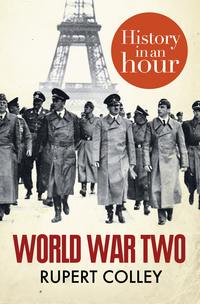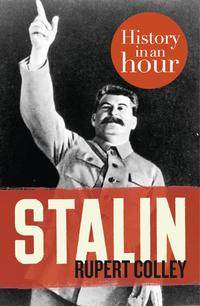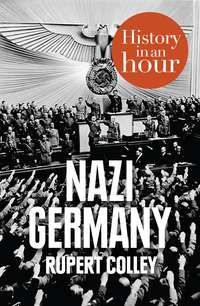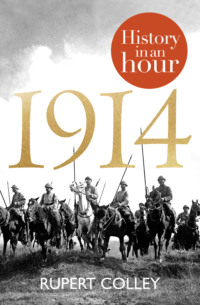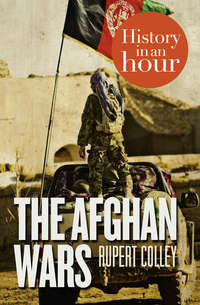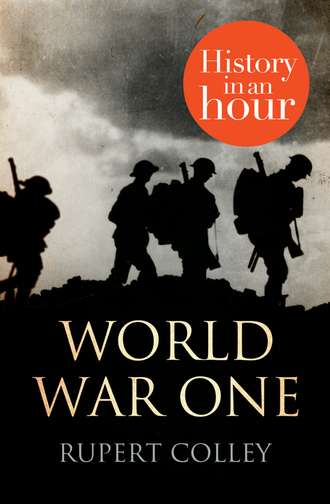
Полная версия
World War One: History in an Hour

WORLD WAR ONE
History in an Hour
Rupert Colley

About History in an Hour
History in an Hour is a series of ebooks to help the reader learn the basic facts of a given subject area. Everything you need to know is presented in a straightforward narrative and in chronological order. No embedded links to divert your attention, nor a daunting book of 600 pages with a 35-page introduction. Just straight in, to the point, sixty minutes, done. Then, having absorbed the basics, you may feel inspired to explore further. Give yourself sixty minutes and see what you can learn . . .
To find out more visit www.historyinanhour.com or follow us on twitter: http://twitter.com/historyinanhour
Contents
Cover
Title Page
About History in an Hour
Introduction
Assassination of an Archduke
The Schlieffen Plan
The Eastern Front
Global War
The War in Britain
The Western Front
Gallipoli
The Ottoman Empire
Verdun
Trenches
Change at the Top
Air and Sea
Ireland and Easter Monday
Russia and Revolution
USA
Passchendaele
The Spring Offensive, 1918
The Hundred Days
Armistice
Paris Peace Conference
The War to End War?
Appendix 1: Key People
Appendix 2: Timeline of World War One
Copyright
Got Another Hour?
About the Publisher
Introduction
The ‘Great War’, as it was originally called, lasted 1,568 days from 28 July 1914 to 11 November 1918, and was without parallel. It brought to an end four dynasties, ignited revolution, and forged new nations. Modern warfare introduced killing on an unprecedented scale, costing an estimated nine million lives. This was a war of new technology and terrifying new weapons. It was the war that killed the idealistic notion of battle – a war without chivalry, romance or glory – a war that shattered mind and body.
This, the first ‘world’ war, was not just about armies winning and losing battles, but whole populations mobilized for war, at the mercy of the enemy, civilians starved and bombed. It was an industrial war where a country’s whole economic output was geared to war; a war of empires that pulled in combatants from nations across the globe. It was a war of land, air and sea, a war of politics, espionage, and also the Home Front. For the first time in history, this was total war.
And this, in an hour, is World War One.
Assassination of an Archduke
It all began with two deaths.
On Sunday, 28 June 1914, the heir to the Austrian–Hungarian (Habsburg) throne, the Archduke Franz Ferdinand and his wife, the Countess Sophie, paid an official visit to Sarajevo, capital of Bosnia, to inspect troops of the Austrian–Hungarian army.
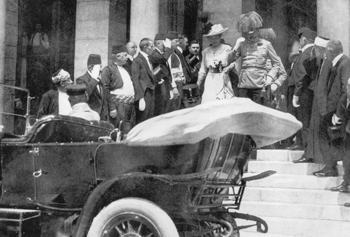
Moments before their death – Archduke Franz Ferdinand and his wife, Sophie, in Sarajevo, 28 June 1914
Bosnia had been a recent and unwilling addition to the Habsburg Empire. Resentful Bosnian Serbs dreamt of freedom and incorporation into the nation of Serbia. Nationalistic groups formed, determined to use violence to strike terror at the heart of the Austrian–Hungarian empire. One such group, the sinisterly named ‘Black Hand’, included among its number a nineteen-year-old named Gavrilo Princip. It was in Sarajevo that Princip would change the world.
Princip and a handful of his Black Hand comrades arrived, each armed with a bomb and, in the event of failure, a vial of cyanide. They joined, at various intervals, the throng of onlookers lined along a 6-km route and waited for the six-car motorcade to come into view. The first two would-be assassins lost their nerve, while the third managed to throw his bomb causing injury to a driver but leaving the Archduke and his wife unharmed. Racked with a sense of failure, Princip trudged to a nearby tavern.
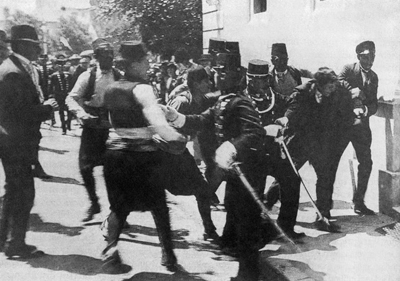
Gavrilo Princip wrested to the ground
The Archduke, having delivered a speech, decided to visit the wounded driver in hospital. On his way, his driver took a wrong turning down a one-way street, a street named after Franz Ferdinand’s uncle the emperor, Franz Joseph, along which was a tavern. Princip, astonished to see the royal car, acted on impulse. Jumping onto the running board as the driver tried to engage the reverse gear, he fired two shots. Mortally wounded, Franz Ferdinand’s last words were: ‘Sophie, stay alive for the children’. It was not to be. The Archduke and his wife died together. It was their fourteenth wedding anniversary.
The Road to War
The assassination of Franz Ferdinand had very much been the work of Princip and his band of Black Hand conspirators but the Austrian–Hungarian empire saw an opportunity to assert its authority over Serbia. First it sought reassurance from its powerful ally, Germany. Together, they had formed the Dual Alliance in 1879 which, three years later, became the Triple Alliance when Italy added its signature. Now, the German Kaiser, Wilhelm II, gave Austria-Hungary the assurance it needed, then promptly went off on a cruise around Norway.
It took the Austrian–Hungarian government three weeks but the ultimatum they sent Serbia was, in the words of Britain’s foreign secretary, Sir Edward Grey, the ‘most formidable document ever sent from one nation to another’. Serbia was given forty-eight hours to comply with ten demands, specifically designed to humiliate and therefore be rejected. Although the Serbs agreed to eight, it was never going to be enough for the bellicose Austrian–Hungarians and on 28 July they declared war on Serbia.
Events now moved quickly, one triggering off another. In response to this declaration of war, Russia, which saw itself as protector of Serbia, began to mobilize. France, Russia’s ally since 1892, offered her its support. In response, the Germans gave Russia twelve hours to halt its mobilization. The deadline passed, thus on 1 August, Germany declared war on Russia and, two days later, on France. ‘The sword has been forced into our hand,’ claimed the Kaiser.
The Schlieffen Plan
Germany now faced a war on both its western and eastern borders; a war on two fronts. But it was a prospect they had long anticipated. In 1905, the then German Chief of Staff, Count Alfred von Schlieffen, had devised a plan for such an eventuality. Russia, he surmised, not incorrectly, would take up to six weeks to mobilize its armies, allowing Germany time to defeat France. In order to avoid the line of fortifications on the Franco-German border, the German army would have to advance through neutral Belgium in a huge sweeping movement: ‘let the last man on the right brush the Channel with his sleeve’. Having knocked out Belgium, it would swing south, covering twenty kilometres a day, and encircle Paris. Having dealt with the French, it would then have time to move east to confront the vast armies of Russia. Schlieffen died in 1913. One year later, his grand plan was put into action.
Speed was of the essence. On 2 August, Germany stormed through Luxembourg and demanded immediate access through Belgium. But ‘Poor little Belgium’, as the British press called her, refused and turned to a 1839 treaty, guaranteeing its neutrality. One of the signatories was Germany. The other was Great Britain. Britain asked Germany for an assurance that they would respect Belgium’s neutrality. Germany ignored it and on 4 August began bombing the city of Liège. Germany could not believe that Britain would go to war with a ‘kindred nation’ over a ‘scrap of paper’ – a treaty signed seventy-five years before. Britain declared war on Germany on 4 August. Sir Edward Grey, gazing out from the Foreign Office, remarked, ‘the lamps are going out all over Europe. We shall not see them lit again in our lifetime’.
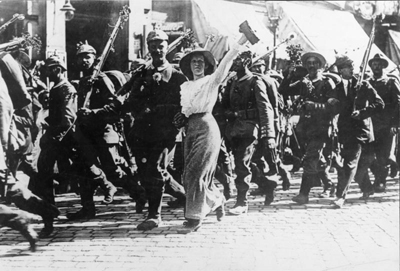
The German army goes off to war, August 1914 Deutsches Bundesarchiv Bild 183-25684-0004
Grey, in his gloominess, was in a minority – the rest of Europe rejoiced at the prospect of war. Everywhere, civilians gathered in town squares to celebrate, young men anticipated adventures of derring-do and chivalry. ‘It’ll all be over by Christmas’, the British army was told; ‘You’ll be home before the leaves fall’, declared the Kaiser to his troops. For the Russian Tsar, Nicholas II, a victorious war would stifle the murmurings of revolution that was infecting his kingdom. For France, still chafing over its defeat in the Franco–Prussian War in 1871, war offered a chance to re-establish its reputation.
Unlike her European counterparts, Britain had no standing army, only a small professional force, the British Expeditionary Force (BEF), numbering a mere 100,000 men (compared, for example, to Germany’s 1.1 million). It was this tiny army that arrived in northern France to bolster the French effort. The Kaiser dismissed the BEF as a ‘contemptible little army’, hence British soldiers took pride in calling themselves the ‘Old Contemptibles’.
The first major confrontation between the Great Powers took place in the Belgium town of Mons on 23 August; Britain’s first battle on mainland Europe since Waterloo almost a century before. The ‘contemptible’ BEF, despite being outnumbered three to one, inflicted huge casualties on the Germans, delayed their advance, and then retreated in good order. The Retreat from Mons was, as legend would have it, guided by the ‘Angels of Mons’, ghostly apparitions who safely led the British soldiers away from the battlefield.
The Germans advanced through France but were rapidly running out of steam, too exhausted to maintain the momentum. By early September they had reached the River Marne, only thirty miles north of Paris. The military commander of Paris, General Joseph Gallieni, was old enough to remember 1871 when the Prussians, Germany’s predecessors, had besieged the capital to the point of starvation. He had no intention of allowing the Germans anywhere near Paris again.
After three days of fighting at the Marne, the Germans looked poised to break through the French and British forces, and onto Paris. Gallieni was to send reinforcements but while he had the troops he had no means to transport them north. In a flash of ingenuity, he seized every available Parisian taxi – 600 of them – crammed each one full of soldiers and sent them on their way to meet the army of the French commander-in-chief, General Joseph Joffre.
The arrival of Gallieni’s taxis saved the day. It was on the River Marne that the Schlieffen Plan came to a shuddering halt. Paris was safe and now it was the turn of the Germans to retreat. They fell back, forty miles north, to the River Aisne where they stopped and dug in. The Allies tried to dislodge the Germans from their defensive positions but, failing to do so, began to dig their own trenches.
General Joffre moved part of his force northwards of the Aisne to try and outflank the Germans. The Germans, now led by Erich von Falkenhayn, moved a comparable number of men to block Joffre’s manoeuvre. Joffre repeated his tactic – as did the Germans, each side constructing trenches as it went along. It developed in what became known as the ‘Race to the Sea’ as each army tried to out lap the other until they both hit the Channel. A similar charade extended the line of trenches south from the Aisne to the Swiss border.
The war of movement had come to an end. The consolidation of defence had triumphed over attack. Stretching 400 miles from the English Channel to Switzerland, lay a network of trenches. They were to remain, by and large, in place for four long years. As 1914 drew to a close, the idea of a short, sharp war had all but vanished. Offence was no match against deeply entrenched defence. Generals on all sides puzzled over this uncomfortable truth.
On Christmas Day, 1914, British troops in the front-line trenches could hear the Germans singing Stille Nacht (Silent Night). The British joined in. Cautiously, soldiers on both sides climbed out of their trenches and walked towards each other across No Man’s Land. They shook hands, exchanged cigarettes, and took photographs of each other. Further up the line, a group of Scots played the Germans at football with helmets for goalposts. The Germans won 3–2. But the festivities had to end. With reluctant handshakes, they each returned to their trenches and grudgingly took up their arms. This fraternization was very much against orders. It was never to happen, to such a large extent, again.
The Eastern Front
War had begun on the Eastern Front. Two Russian armies bore down into East Prussia, while the German army was led by the formidable duo of Generals Paul von Hindenburg and Erich Ludendorff. The Germans, in full possession of Russian plans, decimated the first Russian army. ‘The tsar trusted me,’ wailed the Russian commander, Alexander Samsonov. ‘How can I ever face him again?’ He didn’t – he walked into a nearby wood and shot himself. The second Russian army fared no better. The Battles of Tannenberg and the Masurian Lakes went down as terrible defeats for Russia. The Austrian–Hungarian empire, the instigators of this whole war, was faring no better.
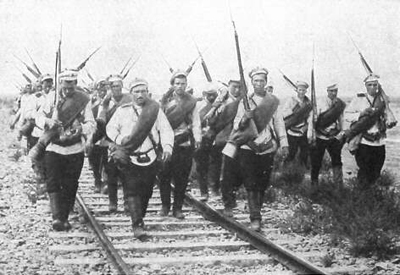
Russian infantry, 1914
The Germans now found themselves in the very situation they had wanted to avoid – a war on two fronts. A system of over 1,000 miles of defensive trenches appeared on the Eastern Front. Although much longer – unlike the Western Front, the front lines were often as much as fifty miles apart – these fronts were not continuous, and were lightly defended. German sources of manpower and equipment were stretched even further when, throughout the war, they were obliged to send reinforcements to help the Austrian–Hungarians. They felt as if they were ‘shackled to a corpse’.
Global War
The British asked their dominions to seize nearby German colonies, requests that were gladly accepted. By October 1914, Samoa had fallen to New Zealand, and German New Guinea and the Bismarck Archipelago (modern-day Papua New Guinea) to Australia.
Japan declared war on Germany on 23 August 1914 and promptly seized all the German-held islands in the North Pacific. In September, Japanese forces landed in neutral China and laid siege to the German base at Tsingtao on the coast of China, capturing it on 7 November.
In Africa, the war was fought against the German colonies. In German East Africa, the maverick German commander, Paul von Lettow-Vorbeck, held out for the whole war, only surrendering on 23 November 1918. Elsewhere, Germany lost its colonies in West Africa with Togoland and Cameroon falling to the Allies, and in the south where South Africa conquered German South West Africa (Namibia) with relative ease.
On 23 May 1915, Italy entered the war on the side of the Allies. Having joined the Triple Alliance with Germany and Austria–Hungary in 1882, Italy had kept its neutrality until lured into war on the Allies’ side by British promises of Habsburg territory.
The War in Britain
Britain had a problem with men – not enough of them. The BEF, the professional army, was too small but the British, unlike its European counterparts, were against conscription. The answer was to raise an army of volunteers. The Secretary of State for War, Field Marshal Lord Horatio Kitchener, went on a recruitment drive. Throughout the country from 7 August 1914, posters adorned with his stern-looking face and pointing finger shouted out, ‘Your Country Needs You’.
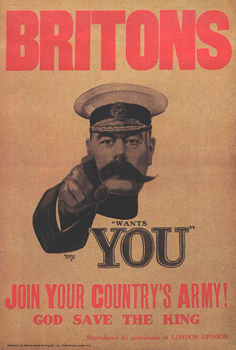
Lord Kitchener’s recruitment poster, 1914
Kitchener and the government hoped for perhaps 100,000 volunteers within the first six months. Any more would cause logistical problems. In the event, they got two million by the end of 1915, such was the extent of British patriotism and British naivety. But these young men were not to blame for their ignorance – news reporting was severely censored and war reporters were barred from the front. Thus, speculation and rumour made up for where fact lacked. A million Russian troops had landed in Scotland and were marching through England – you could see the snow on their boots; the barbaric Germans had tied Belgium nuns to church bells and used them as clappers; and the corpses of German soldiers were being used by the Germans to make candles and boot polish.
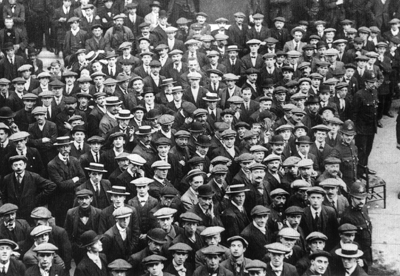
Volunteers for Kitchener’s Army, Trafalgar Square, August 1914. IWM Collections, Q 53234
While men signed up, women took their jobs in factories, on farms, public transport, postal services, and businesses. The war, arguably, advanced the cause of women’s liberation far more than the pre-war suffragette movement. Recognizing the role women played during the war, the British government passed two laws in 1918 that, between them, gave women over thirty the right to vote, and allowed women to stand as Members of Parliament.
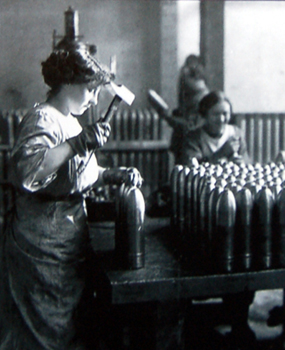
Women at work in a munitions factory, c. 1915
On 27 January 1916, the recruiting of volunteers in Britain came to an end, replaced by conscription. Initially affecting only single men, by May the draft was extended to include married men.
The replacement of the initial mood of optimism with a growing realization of the true horror of modern warfare, is perhaps best reflected in the works of the War Poets. At first, poems extolled the glory of war and the virtues of defending one’s country. Rupert Brooke epitomized the early enthusiasm for war in his sonnet ‘Now God be thanked who has matched us with His hour’. Julian Grenfell, a captain in the British army, wrote in a letter, ‘I adore war. It is like a big picnic but without the objectivelessness of a picnic’. His poem, ‘Into Battle’, in which he wrote of the ‘joy of battle’, was published in The Times on the day of his funeral in May 1915.
Bitterness soon crept in. Siegfried Sassoon, an early enthusiast for the war, had received the Military Cross and was nicknamed Mad Jack for his courageous feats. While recovering from shellshock in Craiglockhart hospital in Scotland, Sassoon wrote of the ‘rank stench of those bodies [that] haunts me still’. Sassoon befriended a fellow patient, Wilfred Owen, who summed up his generation’s disillusionment with war in his poem, ‘Dulce et Decorum est’: ‘You would not tell with such high zest to children ardent for some desperate glory, / The old Lie: Dulce et Decorum est / Pro patria mori’ (‘it is sweet and right to die for your country’). Owen was killed in action a week before the Armistice.
Spies, according to the fevered public imagination, were everywhere – you could spot German spies dressed as nuns by their hairy legs. Genuine Germans were interned on the Isle of Man. Anti-German sentiment ran deep – shops with Germanic-sounding names were attacked, dachshunds, according to popular legend, kicked in the street. Even the Royal Family was not immune, changing its name from Saxe-Coburg-Gotha, a bit of a German giveaway, to Windsor.
In Belgium, English nurse Edith Cavell was caught smuggling wounded Allied soldiers into neutral Netherlands. Despite appeals for clemency, Cavell was executed on 12 October 1915 by firing squad. Cavell had freely admitted her guilt for a crime that carried the death penalty, but the British government seized on the propaganda advantage Cavell’s death provided – the heroic nurse murdered by the German barbarian. Another infamous execution was that of Gertrud Margarete Zelle, an exotic Dutch dancer and performer better known by her stage name, Mata Hari. Accused by the French of being a double agent, she was shot in October 1917.
Hatred of all things German intensified when, on 19 January 1915, German zeppelins bombed Great Yarmouth in East Anglia, killing four people. The first raid on London, on 31 May, killed seven. War had come to England. Compared with the next war, these attacks were few and infrequent, limiting the damage. In total, 557 British civilians lost their lives from bombing throughout the war.
More shocking perhaps was the sinking of the British Cunard cruise liner, the Lusitania off the coast of County Cork, Ireland. Hit by a German U-boat on 7 May 1915, the ship sunk in just eighteen minutes. 1,198 of its 1,959 passengers and crew were killed, of whom 128 were American. The attack on a civilian ship caused outrage but the ship had been carrying a large supply of ammunition and, therefore, in German eyes, made her a legitimate target.
The Western Front
The attrition on both Fronts continued with varying degrees of success and failure; any success being usually short-lived and ultimately inconsequential, yet still costly in terms of lives.
On 22 April 1915, during the Second Battle of Ypres, the Germans introduced a new element to the Western Front – at 5 p.m. a yellowy vapour smelling of chlorine floated over the French lines. It was gas – 5,730 cylinders of it. French and Algerian soldiers, retching and panicked, ran off, leaving a four-mile gap for the Germans to attack unimpeded. However, the Germans, wary of stepping into the cloud protected only by their crude gasmasks, felt unable to exploit the opportunity. This new terrible weapon was inhumane, cried the Allied generals, only to be using it themselves within five months.
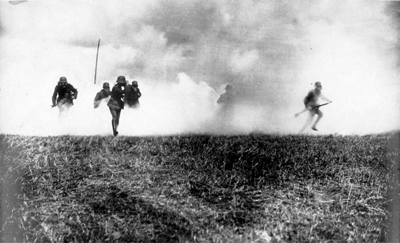
Gas attack, c. 1916 Deutsches Bundesarchiv, Bild 183-R05923
Gas had been used three months before on the Eastern Front but in the freezing temperatures the chemicals froze and failed to vaporize. Having experimented with chlorine, Fritz Haber, pioneer of gas warfare, developed a new, more effective gas, called phosgene, which omitted a smell akin to freshly cut hay. Its first use, again on the Eastern Front, in January 1916, proved successful. Haber and his associates celebrated. Haber’s wife, appalled by her husband’s barbarous innovation, took his service revolver and shot herself.
In 1917, the Germans introduced mustard gas, so named because of its odour, which could penetrate clothing and be absorbed through skin. Gas had become a common feature by the end of the war. Although it was effective at incapacitating troops and causing long-term illness, gas accounted for only 3 per cent of fatalities. Another German invention, the flamethrower, was introduced into battle against the French in February 1915. But it was the artillery that caused by far the most damage throughout the war.
Following Kitchener’s recruitment drive, the British army now had the men but lacked the crucial equipment: weapons, ammunition, clothing, and even accommodation were all lacking. Following British failure at the Battle of Aubers Bridge in May 1915, the British commander-in-chief, Sir John French, leaked the want of ammunition to The Times, which picked up the story, blaming the Liberal government of Lord Asquith. Politically, the ‘Shell Scandal’ proved fatal. The Liberal government was forced into a coalition with the Conservatives. Herbert Asquith remained prime minister, but weakened, he survived for only another nineteen months.


